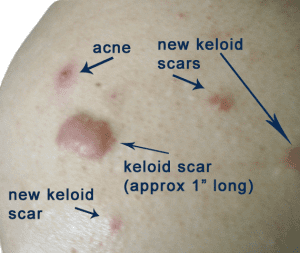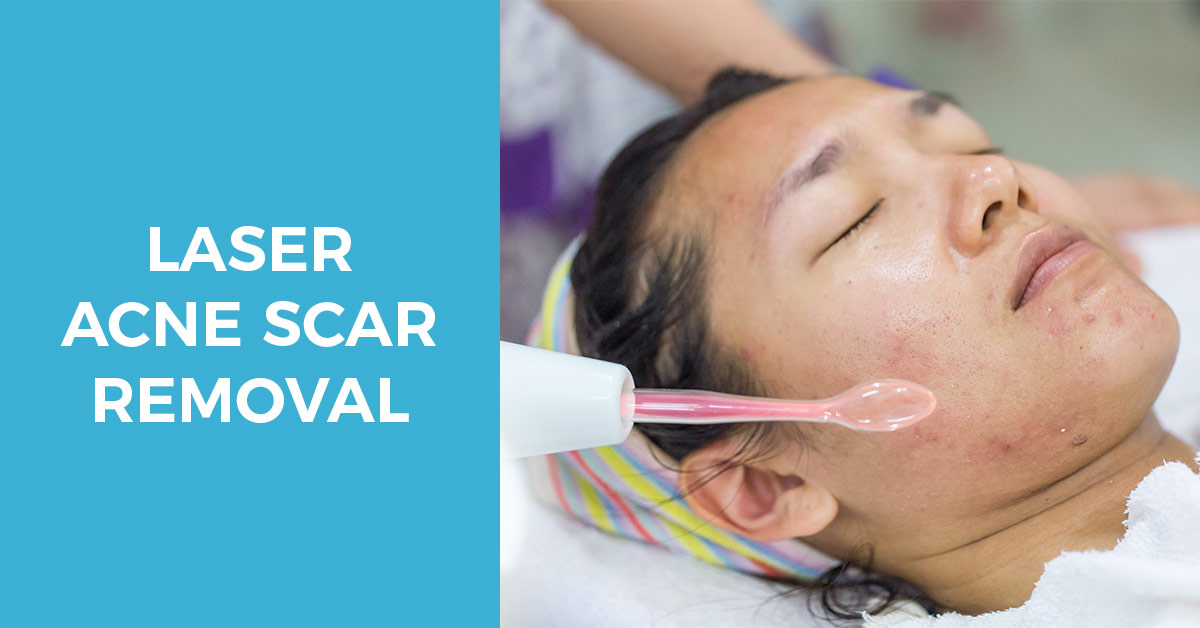Contents
Sound familiar?
Well, you’re not alone. Many of us who suffer from acne, whether it’s in our teenage years or adult life, are left with an all too familiar reminder of the stress and discomfort we went through in fighting our spots. With dark marks or scars remaining firmly in place on our face, back, and other areas of our body, we’re left to fight another battle, and this one can seem tougher than the spot-fighting one we went through before.
And one of the worst things? You don’t even need to have committed the cardinal sin of picking your spots to get these angry-looking scars. They’re sometimes formed because, funnily enough, our bodies are so enthusiastic about getting rid of spots that they produce too much collagen (the protein in our skin), creating a keloid scar that’s raised above your skin.
However, all hope is not lost, because there are some treatments available that aren’t invasive and have a great success rate. One of these is laser acne scar removal, an innovative way of treating your scars without taking drugs, using creams, or going under the knife.
To help you find out if this is the right acne treatment for you, we’ve put together this guide which will explain what’s involved in the acne scar laser treatment process, what types of laser treatments there are available, and what potential side effects there are.
What Causes Acne Scars?
Before we get started, it’s a good idea to familiarize yourself with how acne scars are formed because this will help you understand how the laser process works.
The majority of acne scars are formed because of an inflamed lesion, e.g. a cyst, pustule, or papule. This occurs when your hair follicle (pore) is filled with bacteria, dead skin cells, and excess sebum (the oil your skin produces). The pore expands, which means its wall breaks.
When this happens near the surface of your skin, you’ll often find that the lesion heals quickly and is only minor in form. However, when the follicle wall is more extensively broken, a more serious lesion may form. The infection within the pore now affects your healthy skin tissue and the dermis (the thick layer of tissue underneath your skin’s top layer).
Naturally, your body wants to heal your dermis, which is why new collagen fibers are created to give flexibility and strength back to your skin. However, unfortunately, this quick fix doesn’t always return your skin to its original smooth and flawless appearance, creating permanent scars instead.
The biggest creator of scars is inflammation, and the bigger the inflammation the more likely it is that you’ll get a scar. (You don’t normally get scars from other blemishes that aren’t inflamed, e.g. whiteheads and blackheads).
What Are the Different Types of Acne Scars?
There are a number of different scars that can be caused by acne, including: 
- Keloid Scars: These occur when your body produces too much collagen, creating a bump of tissue that’s raised above the skin’s surface. These are often reddish-purple in color and are firm to the touch. They can also extend further than the initial infected area and may increase over time.
- Hypertrophic Scars: Very similar to the above, these scars are pink, raised, and firm. These do, however, remain within the infected area and can sometimes fade with time.
- Atrophic Scars: These are the most common types of scars caused by acne and have a depressed appearance (pocket-like indentations in your skin). Boxcar and ice pick scars are two different types of this scarring.
- Post-Inflammatory Hyperpigmentation (PIH): Although this isn’t technically a scar, it is a side-effect of acne. It causes your skin to discolor temporarily but this will fade over time. You can speed this process up using a number of medications, including Retin-A.
Laser treatments can be used to improve the appearance of acne scars, and there are two types of laser treatments available:
- Nonablative Laser Treatment: This is a less intense treatment using lasers to encourage the growth of collagen in your skin. This can help repair some of the damage that’s been caused by your scars, improving the appearance of them in the process.
- Ablative Laser Treatment: This treatment is often harsher as a small patch of your skin around your scar is removed by the lasers. This encourages the skin to produce a new patch that’s smoother than what was there before.

The number of treatments and the length of the procedure required will depend on your individual case and the number and severity of the scars that need treating. However, most procedures are carried out under general anesthetic and last around 40 minutes. Over a period of two months, four to six treatments will often be enough to improve the overall appearance of your scars, perhaps even removing them completely.
What Lasers Are Used in Acne Scar Removal?
CO2 Laser Acne Scar Removal
These lasers are often seen as the harshest treatment for acne scar removal, which means they do cause more discomfort. However, due to the intensity, they can provide better results than some of the other less-harsh lasers (e.g. fractional lasers).
CO2 lasers are ablative ones as they destroy your skin’s surface and the layers underneath it which have caused your scars. Because of this, you need to be prepared for a longer recovery time, as they do cause some damage to your skin that can leave it looking redder than usual. This redness may last for three months but you’ll often find that this temporary side effect is more than worth it with a visible improvement in the appearance of your scars.
The below video by Kassandra takes you through her journey with CO2 laser treatment, including before and after videos.
Er:YAG (Erbium:YAG) Laser Acne Scar Removal
This is another ablative laser but is less harsh than CO2, causing less damage to your skin. It works in much the same way as the above process, destroying your skin’s surface layers and the scars to create smoother-looking skin.
However, as these lasers are weaker than their CO2 counterparts, the redness, pain, irritation, and swelling associated with CO2 lasers is lessened. This also significantly decreases the recovery period to a little over a week, but it does reduce the effectiveness too. That’s why Er:YAG lasers are better suited for mild or moderate scars rather than severe ones. Equally, if you’ve got a darker skin tone, these lasers may reduce the risk of you developing hyperpigmentation after the treatment.
Fraxel/Fractional Laser Acne Scar Removal
Again, these lasers work very similarly to those mentioned above but this involves a nonablative process. Therefore, the skin isn’t damaged as much.
They work by targeting the scarred areas but in a much more precise way than the other lasers. Thus, fewer side effects are caused, with the risk of irritation, pain, reddening, bruising, and swelling being significantly decreased. The healing time for this treatment is around one week but due to how much weaker these lasers are you will often find that you need more treatments and they won’t be effective on moderate or severe scars.
The Side Effects of Ablative Laser Acne Scar Removal
A number of side effects can be caused by ablative lasers, including:
- Itching, swelling, and redness: The skin that’s been treated by the lasers will be red, swollen, and itchy after the treatment. How red your skin is will depend on how deep the resurfacing has gone. In intense cases, you may find your redness lasts for several months. The process can aggravate previous skin conditions, too, e.g. rosacea, adding to the redness of your skin.
- Infections: Sometimes, a fungal, viral, or bacterial infection can be caused by ablative lasers. The most common of these is the herpes virus (this is the virus that results in cold sores), which can be aggravated by the lasers when it’s been lying dormant in your skin.
- Acne: Unfortunately, even though you’re trying to get rid of acne scars, ablative lasers can cause further breakouts. This is due to the bandages and thick creams you need to use after your treatment, which can make your acne worse or lead to you developing milia (tiny white bumps) temporarily on your skin.
- Changes to your skin color: Treated skin can sometimes go lighter than normal (hypopigmentation) or darker than normal (hyperpigmentation) after treatment. The latter is more common if you have a darker skin tone. To help get rid of this, you can use glycolic acid or topical retinoic acid to treat the area once it has healed. It’s also important to use sunscreen after your treatment. Nonablative fractional photothermolysis may be recommended if you’re suffering from hypopigmentation.
- Scarring: There’s a slight risk of further scarring when you have ablative laser resurfacing.
- Ectropion (turning of the eyelid): In very rare cases, ablative lasers that are used close to the lower eyelid can cause it to turn out, exposing the inner layer of your eyelid. If this occurs, surgery will be required to correct it.
The Side Effects of Nonablative Laser Acne Scar Removal
Nonablative lasers can cause a number of side effects, including:
- Infection: Again, these types of lasers may cause the previously dormant herpes virus to flare up.
- Changes to your skin color: If you have darker or tanned skin, hyperpigmentation may occur for a temporary period after nonablative laser resurfacing.
- Redness and mild swelling: If this does occur, it will only last a matter of hours or days.
- Scarring and blistering: In very rare cases, scarring and blistering can be caused.
Who’s the Ideal Candidate for Laser Acne Scar Removal?
Laser acne scar removal isn’t suitable for everyone, and your doctor may suggest you’re not an ideal candidate if:
- You still have acne
- You’ve got very dark skin
- You’ve taken isotretinoin (Claravis or Amnesteem) for your acne in the past year
- You have a weak immune system or an autoimmune disease
- Your skin tends to form scars
To find out whether acne scar laser treatment is right for you, you should consult your doctor or dermatologist for their professional advice.
These often include washing the treated area gently using mild soap, patting (not rubbing) it dry, and applying an antibiotic cream before wrapping it up in a non-stick bandage. You may also be prescribed an antibiotic tablet to ward off any infections.
Sometimes you’ll be given a medicated cream to help fade the scar even more. Often, cool masks can help soothe your skin afterward, while oral painkillers are recommended if you’re in pain or discomfort. However, if you’re finding the pain unbearable you should seek medical advice straight away.
How quickly your skin regenerates will depend on a number of factors including your skin’s individual characteristics, the laser that’s been used, and how well you look after the area following your treatment. You’ll be asked to return to see your doctor a number of weeks after the treatment to see how your skin’s progressing. At this point, further treatment may be recommended.
Questions to Ask Your Surgeon About Laser Acne Scar Removal
- What laser acne scar removal options are available to me, and which one is right for the scars I have?
- How much will the procedure cost (approximately)?
- How long does one treatment last for?
- How often will I need this treatment?
- How long do I have to wait in between treatments?
- What can I do to prepare myself for the procedure?
- Will it hurt?
- How long will it take for me to recover?
- What are my anesthesia and pain management options?
- Can I see some before-and-after pictures so I know what to expect?
- Will someone be able to talk me through the entire process so I know what’s involved in my procedure?
- What risks are associated with the treatment?
- What should I expect afterward, e.g. short- and long-term effects, restrictions, aftercare, and so on.
However, nothing’s better than hearing first-hand how someone got on with their own laser treatment and thankfully, Katie Becker shared her story with Elle magazine. She talks you through all the stages involved in laser acne scar removal, including how it feels and what you can expect after.
Have you undergone laser acne scar removal? What treatment did you have and how effective did you find it? We’d love it if you could share your own personal stories with our readers below!



